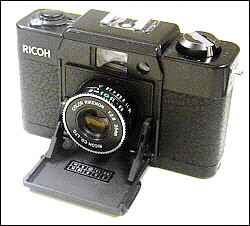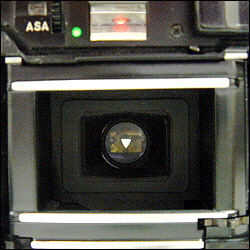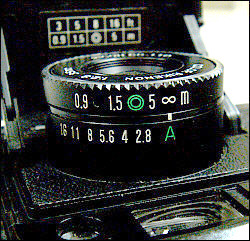Ricoh FF-1

|
|
|
| Style, film format | 35mm scale-focus folding camera |
|
|
|
| Lens, shutter | Retractable coated f/2.8 35mm Rikenon in electronically controlled leafshutter |
|
|
|
| Photo quality | To come |
|
|
|
| Ergonomics | Despite its small size, very easy to hold and to use. |
|
|
|
In the late 1970s, the downsizing of cameras was in full swing. Smaller was better.
Among SLRs, Olympus led the way with its OM-1, while the point and shoot rangefinders went on a diet as well with offerings from Canon, Olympus, Minolta, Konica, Rollei and several others.
Then there was the third category of pocket 35mm cameras. Rollei had enjoyed a huge amount of success for more than a decade with its Rollei 35. The Minox 35 series of cameras were worthy competitors, and the Olympus XA was building a base of loyal users.
A lesser known camera was the Ricoh FF-1. It's not a rare camera, but it's a camera that isn't mentioned during most discussions of pocket 35mm cameras.
The FF-1 is a mix of metal and plastic, reasonably well made with a shutter advance lever and a couple of unique features.
The camera has a four-element Tessar-type 35mm lens. It's reasonably fast at f/2.8. The retractable lens is protected by a fold-down lens door.
From everything that I've read, the electronically controlled leaf shutter has a range of 2 seconds to 1/500, and my informal tests seem to confirm that on the slow end. The camera is powered by two S76/LR44 batteries. The shutter won't fire without batteries. It might sound like it's firing, but it's not. There is no default "no batteries" shutter speed, so make sure that you always have a set up backup batteries, if this will be your only camera.

The exposure system is either programmed autoexposure or aperture-priority autoexposure. I've found that the best way to turn the aperture dial with the thumbs of both hands. The serrations on the aperture dial don't provide enough grip to turn it with one hand.
The lens has a three-blade aperture, which form a triangle that is clearly visible at smaller apertures.
The meter eye is next to the viewfinder, rather than the lens, which you see with most cameras.
The film is advanced with a single 90-degree throw of the plastic-tipped lever. The shutter release is an oversized round button with a metal threaded cable release socket just above it. The film counter sits to the left of the shutter release. The top deck is completed by a hot shoe and the rewind crank.
An unusual feature of the rewind crank is that when folded close, it doesn't turn when the film is advanced. It's a novel approach, and I rather like it.

The hinged back is opened by pulling down on a small lever on the side of the camera. The camera also has a metal tripod socket and a standard rewind button. Next to the eyepiece is another small dial that lets you set the film speed. It's ASA only – no DIN speeds, which is unusual because the lens on my camera is marked in meters. There is a small meters-to-feet conversion table on the inside of the lens door.
By the way, when the door is closed, the meter cannot be activated. That helps to prevent accidentally running down the batteries, especially important because -- as I mentioned earlier -- the camera is battery dependent.
Focusing this camera is accomplished by your best guess. The 35mm focal length should help to compensate for focusing errors.
From what I can tell, the shutter release doubles as a battery tester. If there is sufficient power, a small green LED to the left of the viewfinder lights up. A small red LED above the viewfinder lights if there isn't enough light.
The viewfinder has framelines. The viewfinder is centered over the lens. The viewfinder doesn't have any parallax marks, although you would think that it would for shots closer than six feet. There are no surprises with how the camera operates, and it's light and small enough to slip into a pocket.
As with nearly all Japanese cameras, I had to replace the foam seals, which turned out to be a bit messier and complicated than I expected. And the leather covering was so sticky and gross that I had to replace it.
